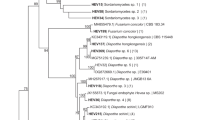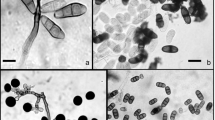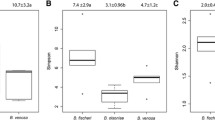Abstract
Foliar fungal endophytes are an important plant-associated fungal group. However, little is known about these fungi in hemi-parasitic plants, a unique plant group which derive nutrients from living plants of its hosts by haustoria while are photosynthetic to some degree. In this paper, the endophytic fungi in the leaves of a species of hemi-parasitic plant, Macrosolen cochinchinensis, were studied by both culture-dependent and culture-independent methods. By culture-dependent method, a total of 511 isolates were recovered from 452 of 600 leaf fragments (colonization rate = 75.3 %) and were identified to be 51 taxa. Valsa sp. was the most abundant (relative abundance = 38.4 %), followed by Cladosporium sp. 1 (13.5 %), Ulocladium sp. (4.3 %), Phomopsis sp. 2 (3.7 %), Hendersonia sp. (3.5 %), and Diaporthe sp. 4 (3.5 %). The Shannon index (H′) of the isolated endophytic fungi was 2.628, indicating a moderate diversity. By culture-independent method, Aspergillus spp., Cladosporium sp., Mycosphaerella sp., Acremonium strictum, and Tremella sp. were detected. To our knowledge, the Tremella species have never been detected as endophytes so far. In addition, a cloned sequence was not similar with any current sequence in the Genbank, which may represent a novel species. Altogether, this study documented endophytic fungal assemble in the leaves of M. cochinchinensis which was worthy of our attention, and may expand our knowledge about endophytic fungi within the photosynthetic tissues of plants.




Similar content being viewed by others
References
Arnold AE (2007) Understanding the diversity of foliar endophytic fungi: progress, challenges, and frontiers. Fungal Biol Rev 21:51–66
Arnold AE, Engelbrecht BMJ (2007) Fungal endophytes double minimum leaf conductance in seedlings of a tropical tree. J Trop Ecol 23:369–372
Arnold AE, Henk DA, Eells RL, Lutzoni F, Vilgalys R (2007) Diversity and phylogenetic affinities of foliar fungal endophytes in loblolly pine inferred by culturing and environmental PCR. Mycologia 99:185–206
Arnold AE, Lutzoni F (2007) Diversity and host range of foliar fungal endophytes: are tropical leaves biodiversity hotspots? Ecology 88:541–549
Barnett HL, Hunter BB (1998) Illustrated genera of imeperfect fungi. American Phytopathological Society Press, St. Paul
Bills GF (1995) Analyses of microfungal diversity from a user’s perspective. Can J Bot 73:33–41
Botella L, Diez JJ (2011) Phylogenic diversity of fungal endophytes in Spanish stands of Pinus halepensis. Fungal Divers 47:9–18
Fröhlich J, Hyde KD, Petrini O (2000) Endophytic fungi associated with palms. Mycol Res 104:1202–1212
Gao XX, Zhou H, Xu DY, Yu CH, Chen YQ, Qu LH (2005) High diversity of endophytic fungi from the pharmaceutical plant, Heterosmilax japonica Kunth revealed by cultivation-independent approach. FEMS Microbiol Lett 249:255–266
Gazis R, Chaverri P (2010) Diversity of fungal endophytes in leaves and stems of wild rubber trees (Hevea brasiliensis) in Peru. Fungal Ecol 3:240–254
Gennaro M, Gonthier P, Nicolotti G (2003) Fungal endophytic communities in healthy and declining Quercus robur L. and Q. cerris L. trees in northern Italy. J Phytopathol 151:529–534
Guo LD, Hyde KD, Liew ECY (2000) Identification of endophytic fungi from Livistona chinensis (Palmae) based on morphological characters and rDNA sequences. New Phytol 147:617–630
Guo LD, Hyde KD, Liew ECY (2001) Detection and taxonomic placement of endophytic fungi within frond tissues of Livistona chinensis based on rDNA sequences. Mol Phylogenet Evol 20:1–13
Hanlin RT (1998) Illustrated genera of ascomycetes. American Phytopathological Society Press, St. Paul
Heckman DS, Geiser DM, Eidell BR (2001) Molecular evidence for the early colonization of land by fungi and plants. Science 293:1129–1133
Jaber LR, Vidal S (2009) Interactions between an endophytic fungus, aphids, and extrafloral nectaries: do endophytes induce extrafloral-mediated defences in Vicia faba? Funct Ecol 23:707–714
Khan AL, Hamayun M, Kim YH, Kang SM, Lee JH, Lee IJ (2011) Gibberellins producing endophytic Aspergillus fumigatus sp. LH02 influenced endogenous phytohormonal levels, isoflavonoids production and plant growth in salinity stress. Process Biochem 46:440–447
Matsumura E, Fukuda K (2013) A comparison of fungal endophytic community diversity in tree leaves of rural and urban temperate forests of Kanto district, eastern Japan. Fungal Biol 117:191–201
Murali TS, Suryanarayanan TS, Geeta R (2006) Endophytic Phomopsis species: host range and implications for diversity estimates. Can J Microbiol 52:673–680
Nickrent DL, Musselman LJ (2010) Introduction to parasitic flowering plants. Plant Health Instr. doi:10.1094/PHI-I-2004-0330-01
Peršoh D, Melcher M, Flessa F, Rambold G (2010) First fungal community analyses of endophytic ascomycetes associated with Viscum album ssp. austriacum and its host Pinus sylvestris. Fungal Biol 114:585–596
Petrini O (1986) Taxonomy of endophytic fungi of aerial plant tissues. In: Fokkema NJ, Van den Heuvel J (eds) Microbiology of the phyllosphere. Cambridge University Press, Cambridge, pp 175–187
Petrini O (1991) Fungal endophytes of tree leaves. In: Andrews JH, Hirano SS (eds) Microbial ecology of leaves. Spring Verlag, New York, pp 179–197
Pinto LSRC, Azevedo JL, Pereira JO, Vierira MLC, Labate CA (2000) Symptomless infection of banana and maize by endophytic fungi impairs photosynthetic efficiency. New Phytol 147:609–615
Rocha ACS, Garcia D, Uetanabaro APT, Carneiro RTO, Araújo IS, Mattos CRR, Góes-Neto A (2011) Foliar endophytic fungi from Hevea brasiliensis and their antagonism on Microcyclus ulei. Fungal Divers 47:75–84
Santamaria O, Diez JJ (2005) Fungi in leaves, twigs and stem bark of Populus tremula from northern Spain. Forest Pathol 35:95–104
Schulz B, Boyle C, Draeger S, Römmert AK, Krohn K (2002) Endophytic fungi: a source of novel biologically active secondary metabolites. Mycol Res 106:996–1004
Schulz B, Boyle C (2005) The endophytic continuum. Mycol Res 109:661–686
Siebe TN (2007) Endophytic fungi in forest trees: are they mutualists? Fungal Biol Rev 21:75–89
Taylor TN, Krings M (2005) Fossil microorganisms and land plants: associations and interactions. Symbiosis 40:119–135
Vega FE, Posada F, Aime MC, Pava-Ripoll M, Infante F, Rehner SA (2008) Entomopathogenic fungal endophytes. Biol Control 46:72–82
White TJ, Bruns T, Lee S, Taylor J (1990) Analysis of phylogenetic relationships by amplification and direct sequencing of ribosomal RNA genes. In: Innis MA, Gefland DH, Sninsky JJ, White TJ (eds) PCR protocols: a guide to methods and applications. Academic Press, NewYork, pp 315–322
Zhang P, Zhou P, Yu L (2009) An endophytic taxol-producing fungus from Taxus media, Cladosporium cladosporioides MD2. Curr Microbiol 59:227–232
Acknowledgments
We are deeply grateful to Prof. Guo Liang-Dong, Dr. Sun Xiang, and Dr. Sun Dong-Xu for their valuable suggestions to the improvement of our manuscript. Special thanks are due to Dr. Wang Mei-Xia and Dr. Dai Qun for their kindly helps in the experiments. This study was supported by the fund of National Natural Science Foundation of China (Project no. 31300067).
Author information
Authors and Affiliations
Corresponding author
Rights and permissions
About this article
Cite this article
Zhou, SL., Yan, SZ., Liu, QS. et al. Diversity of Endophytic Fungi Associated with the Foliar Tissue of a Hemi-Parasitic Plant Macrosolen cochinchinensis . Curr Microbiol 70, 58–66 (2015). https://doi.org/10.1007/s00284-014-0680-y
Received:
Accepted:
Published:
Issue Date:
DOI: https://doi.org/10.1007/s00284-014-0680-y




